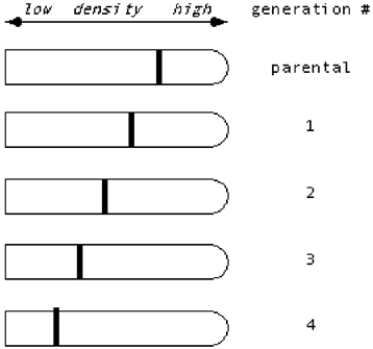Multiple Choice
Suppose Meselson & Stahl had observed the following data in their famous experiment involving a switch from medium containing 15N to 14N. What would they have concluded about the nature of DNA replication? 
A) They still would have concluded that DNA replication is semiconservative, i.e., each double helix contains one parental strand and one newly synthesized strand.
B) They would have concluded that DNA replication is conservative, i.e., one double helix contains only the parental strands, while the other contains only newly synthesized DNA.
C) They would have concluded that DNA replication is dispersive/random, i.e., each strand of each double helix contains a mixture of parental and newly synthesized sequences.
D) They would have been unable to distinguish which is correct.
Correct Answer:

Verified
Correct Answer:
Verified
Q3: The enzyme that attaches the Okazaki fragments
Q4: The famous Meselson and Stahl experiment showed:<br>A)
Q11: Which of the activities of DNA Polymerase
Q15: Which of these proteins is used less
Q19: Okazaki fragments are<br>A) short DNA pieces that
Q19: Exhibit 10A Consider the following diagrams showing
Q44: When the synthesis of new DNA is
Q50: If replication were conservative instead of semi-conservative,
Q51: Recombination:<br>A) occurs randomly throughout a chromosome<br>B) occurs
Q52: Which of the following is not a